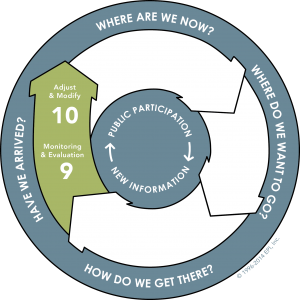We were approached by the Council for the Advancement of Native Development Officers (Cando) to write a quarterly article on the strategic planning process for their newsletter – ‘N-Side’. Cando is a great organization that provides support and capacity building for Economic Development Officers in First Nations communities.
Cando has now published 4 of the 5 articles in the series, and we thought we’d republish the articles here on our blog as they come out (though, admittedly, they are a bit long for a blog post!). The articles follow the 10 step strategic planning process that we use in all our work, and each article will highlight a few of the planning steps. We are happy to share this information and hope that it is useful for your planning processes. If you are going to use the information in toolkits, guides, or other materials please give us credit.
The following article was published in the December 2013 issue of Cando N-Side News.

By William Trousdale and Colleen Hamilton, EcoPlan International
This is the fifth and final installment in a series on the value of strategic planning for local economic development. The articles offer practical tips, case studies and descriptionsof a strategic planning process that can be used for economic development.

The planning process we are describing follows a ten-step process, structured around four Big Questions (see image). In this article, we’ll be working through the final Big Question – HAVE WE ARRIVED? – in which we’ll be creating a Monitoring and Evaluation strategy to make sure that our actions are having the desired economic impacts.
What is Monitoring and Evaluation?
Monitoring and evaluation (M&E) is the ongoing process of checking up on how the economic development plan is working, and making changes to it if needed. Even an excellent plan can fail if there is no M&E.
There are two main things that need to be monitored and evaluated.
- Whether or not the actions in your economic development plan are being carried out as planned (we call this “process monitoring”) and
- Whether or not those actions are having the desired effect on your community’s objectives (we call this ‘outcomes monitoring’). Objectives could be things like ‘create new high quality jobs’ or ‘raise average income levels’.
Collecting information on the economic development process and outcomes, and making changes based on this information should result in the gradual evolution of the economic development plan, taking the community closer to its envisioned future.
It’s important to realize (and to emphasize to your participants!) that M&E is not being carried out to find fault or be critical. It is carried out to incorporate changing circumstances in the community and to improve the chances of project success.
How to Monitor and Evaluate
M&E does not need to be a complicated process. While there are many ways to conduct M&E, the best method is one that will actually get implemented, so it is best to keep it simple. A simple M&E strategy should include:
- A checklist for ‘process monitoring’: Are participants doing what they said they would do in the implementation plan? For example, have you hired a new economic development assistant or created a new website for investment attraction? You can easily create a checklist tool by taking your implementation plan (from previous planning steps – see previous articles) and adding a few new columns to track completion dates and explain why the action has or has not been completed.
- A plan for ‘outcomes monitoring’: Have you heard the expression “You can’t manage what you can’t measure”? It’s hard to know how well your economic development plan is working if you don’t have measurable indicators for each of the community’s objectives. Indicators are statistics that give information about the objective.
Start with your community’s objectives from previous planning steps and think about what types of measurable indicators relate to each objective. The chart below shows some examples.
BE CAREFUL: Try to only choose indicators that you can easily get data for. For example, creating an indicator like ‘percentage of community members that feel satisfied with their jobs’ would probably require creating a survey and could take a lot of extra work each year. Try to keep it simple and use indicators that you can easily find from other sources. M&E is more likely to happen if you keep it simple!
- A timeline for monitoring and evaluation activities: While this will vary from place to place, it’s good to schedule a check-in meeting to discuss project implementation and progress at least every six months. If you don’t make the time to do this, it is unlikely to happen on its own.
- A process for making changes: So, perhaps you’ve done the process and outcomesmonitoring and you find out that the plan is not being implemented on time and it is not having the desired effect (this is the ‘evaluation’ part of M&E). Now what? It’s important to have a process for making changes. Perhaps the plan is updated yearly and is distributed to local business owners and other participants for feedback before approval by Council.
This is the final installment of this series on strategic planning for local economic development. While many of the steps are simple and obvious, taken as a whole they provide a structure and process to create economic development strategies that meet the needs of the community and are realistic and feasible.
We would love to hear your thoughts and experiences on using strategic planning for local economic development. Get in touch to continue the conversation.
William Trousdale is the lead author of: “Promoting Local Economic Development through Strategic Planning” by UN-HABITAT and EcoPlan International (contact him for a copy). He can be reached at william ecoplan
ecoplan ca. Colleen is an associate at EcoPlan and can be reached at colleen
ca. Colleen is an associate at EcoPlan and can be reached at colleen ecoplan
ecoplan ca.
ca.
